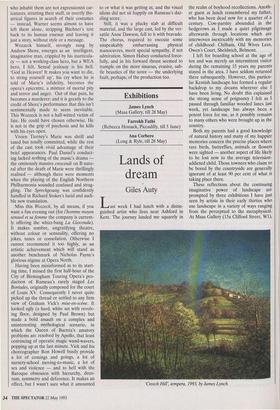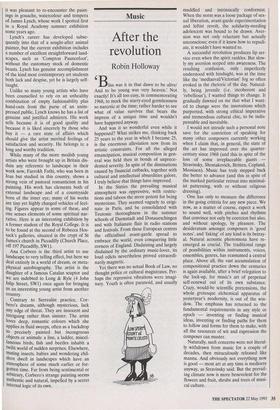Exhibitions
James Lynch (Maas Gallery, till 28 May) Farrokh Fathi (Rebecca Hossack, Piccadilly, till 5 June) Ana Corbero (Long & Ryle, till 28 May)
Lands of dream
Giles Auty
Last week I had lunch with a distin- guished artist who lives near Ashford in Kent. The journey landed me squarely in
the realm of boyhood recollections. Anoth- er guest at lunch remembered my father, who has been dead now for a quarter of a century. Cow-parsley abounded in the hedgerows as I made a quiet pilgrimage afterwards through locations which are interwoven inextricably with my memories of childhood: Chilham, Old Wives Lees, Owen's Court, Sheldwich, Belmont.
I left for boarding school at the age of ten and was merely an intermittent visitor during the remaining 15 years my parents stayed in the area. I have seldom returned there subsequently. However, this particu- lar Kentish landscape has formed a regular backdrop to my dreams wherever else I have been living. No doubt this explained the strong sense of poignancy I felt as I passed through familiar wooded lanes last week, yet landscape has always been a potent force for me, as it possibly remains to many others who were brought up in the country.
Both my parents had a good knowledge of natural history and many of my happier memories concern the precise places where rare birds, butterflies, animals or flowers were sighted — another aspect of life likely to be lost now to the average television- addicted child. Those townees who claim to be bored by the countryside are generally ignorant of at least 90 per cent of what is taking place there.
These reflections about the continuing imaginative power of landscape are prompted by three exhibitions I have just seen by artists in their early thirties who use landscape in a variety of ways ranging from the perceptual to the metaphysical. At Maas Gallery (15a Clifford Street, W1), `Creech tempera, 1993, by James Lynch it was pleasant to re-encounter the paint- ings in gouache, watercolour and tempera of James Lynch, whose work I spotted first in a Royal Academy summer exhibition some years ago.
Lynch's career has developed subse- quently into that of a sought-after animal painter, but the current exhibition includes a number of excellent straightforward land- scapes, such as 'Compton Pauncefoot', without the customary stock of domestic beasts. Lynch has genuine accomplishment of the kind most contemporary art students both lack and despise, yet he is largely self- taught.
Unlike so many young artists who have been counselled to rely on an unhealthy combination of empty fashionability plus hand-outs from the purse of an unim- pressed public, Lynch knows he has a list of genuine and justified admirers. His work sells because it is of good quality and because it is liked sincerely by those who buy it — a rare state of affairs which should give the artist merited feelings of satisfaction and security. He belongs to a long and worthy tradition.
While many of the more modish young artists who were brought up in Britain dis- dain any reference to landscape in their work now, Farrokh Fathi, who was born in Iran but studied in this country, shows a strong vein of pastoral romanticism in his painting. His work has elements both of external landscape and of a countryside born of the inner eye; many of his works are tiny yet highly charged vehicles of feel- ing. Figures appear in some of these, and One senses elements of some spiritual nar- rative. Here is an interesting exhibition by a former student of the Royal College. It is to be found at the second of Rebecca Hos- sack's galleries, situated in the crypt of St James's church in Piccadilly (Church Place, off 197 Piccadilly, SW1).
Ana Corbero is the third artist to use landscape to very telling effect, but here we deal entirely in a world of dream, or meta- physical autobiography. The artist is the daughter of a famous Catalan scuptor and we are indebted to Long & Ryle (4 John Islip Street, SW1) once again for bringing us an interesting young artist from another country.
Contrary to Surrealist practice, Cor- bero's dreams, although mysterious, lack any edge of threat. They are innocent and intriguing rather than sinister. The artist loves deep, romantic colours which she applies in fluid sweeps, often as a backdrop to precisely painted but incongruous objects or animals: a line, a ladder, miscel- laneous birds, fish and beetles inhabit a twilit world of sudden surprises. Elsewhere, mating insects, babies and wondering chil- dren dwell in landscapes which have an atmosphere of some much earlier or for- gotten time. Far from being sentimental or arbitrary, Corbero's strange painting seems authentic and natural, impelled by a secret internal logic of its own.



















































 Previous page
Previous page